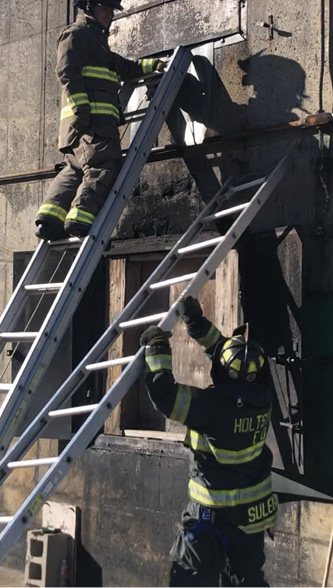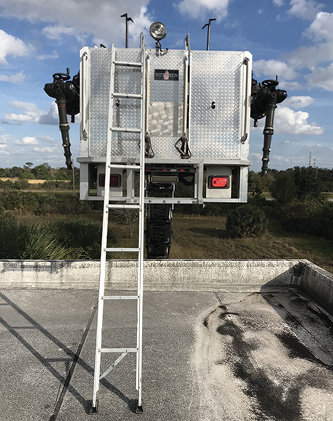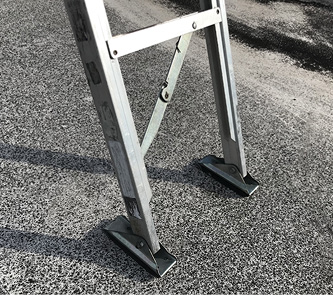On each call the truck company responds to, firefighters will have to use tools, tactics, and their brains to overcome, solve, or attack a problem they encounter on a fireground or rescue scene. Becoming well-versed in truck company operations will take time, since there are so many tasks that a truck performs. The “LOVERS-U” acronym represents the following truck company tactical operations: L-Ladders, O-Overhaul, V-Ventilation, E-Entry, R-Rescue, S-Search and Salvage, U-Utilities.
For young firefighters learning the trade, it can be overwhelming to learn all the department procedures and guidelines to perform the list of “required jobs to get done.” Many times, it won’t be until the firefighters get into the firehouse and work with other firefighters that they’re exposed to some of the other shortcuts, tips, or tricks of the trade performed on the streets. They will find that ladders are used much differently on the streets vs. what they learned in the academy.
Ladder Placement
Early in my career, I remember a short adage that has always stuck with me: “Ladder for life.” Of course, many of us think right away that’s because when we pull up with a victim in a smoke-filled window, the quickest thing to do is raise a portable ladder and make the removal. That’s great and, of course, what we should be doing on arrival, but is that really the whole meaning of the adage?
RELATED FIREFIGHTER TRAINING
Ladder Company Positioning Tips for Encountering Obstacles
Truck Company Operations: Boston’s Ladder Culture
Are You Ground Ladder Savvy? Part 1 | Part 2
When we arrive at most private dwellings, the bedrooms are on the second floor and where we concentrate our search efforts for victims at certain hours of the day. Normally, we’ll be using the main entrance and working up the stairwell and down the hallway to these locations. What happens when we do make it up there and we’re suddenly cut off by the fire? Will we have another means of egress? This is especially true in newer construction in private homes with open balconies that overlook the family room, allowing the fire to rapidly extend to the upper floor. Placing portable ladders to the second-floor windows allows us an emergency means of exiting the structure. It also allows us to remove victims to fresh air faster instead of exposing them to the hazardous atmosphere in the hallway, down the stairs, and out the front door.
Is removing unconscious victims using a ladder easy? It isn’t unless you’ve trained on it and understand everything isn’t like you learned from the textbooks. Having the tip of the ladder below the sill keeps it out of the way, and a piece of clothing is less likely to get snagged on it when you hand a person out. One of the first tips for accepting the victim is to try and get both of your hands on the back of the ladder rails. This way, when you climb down, you don’t have to release a rung and feel for the next lower one, which may cause the victim to slip, change position, or be unsupported and fall to the ground.
While you climb down with your hands on the rails, you’re sliding along the rails with the victim’s weight carried in your arms the whole time. If you feel them slipping or need a break to grab a breath of air, press the victim into the ladder with your chest. Doing this will “pin” the victim to the ladder, allowing you to readjust your arm position or catch a victim who slips (photo 1).

(1) Firefighters should slide their hands down the back of the rails so they don’t lose contact with the ladder while transporting a victim. (Photos by JJ Cassetta.)
If you’re the firefighter footing the ladder, you can climb up and put your hand on the downward-climbing firefighter’s buttocks, offering support and vocal direction as to the next rung’s location. Don’t press the butt too hard; he has to be able to move his legs from rung to rung.
Any additional firefighters in the area shouldn’t just stand there and watch! They should grab another ladder and place it next to the original ladder at any angle. They might have to angle it up from beneath the victim or throw it to the side of the original ladder’s position. It probably won’t be a textbook raise. You might have to muscle it up or slide it up the side of the structure with the tip supported on the building to get it into position (photo 2).

(2) Drilling on single-firefighter ladder raises will enhance your knowledge and allow you to train for the unforeseen on the fireground.
Once the second ladder is in position, a firefighter should climb it and grab onto the victim’s legs or arms or support from beneath. Performing this simple task will take a lot of weight and pressure off the firefighter climbing down the ladder with the victim over his arms (photo 3).
Many firefighters are quick to throw roof ladders to porches if they’re not needed to vent a roof. That’s another benefit if you have to exit to the porch roof—you’ll now be able to descend to safety quickly. Another benefit of the ladder placed there is if it’s already on the building, it is easy to retrieve and throw next to the ladder rescue as a second ladder in the operation.

(3) A firefighter operating on an adjoining ladder is trying to support the victim and take some of the weight off the firefighter carrying the bulk of the victim’s weight.
As a truck company, strive to have ladders on each side of a dwelling or, at a bare minimum, one to the front and back. You’re adding insurance for those operating inside. Many of us prefer the old adage, “The more the merrier,” and if you’ve ever operated in a balloon-frame structure and the place has “lit up” on you, having a ladder at the window is better than deploying a personal safety rope or risking diving down a fully engulfed stairwell to safety.
Attic/Folding/Scissor Ladder
An often-underused tool for some truck companies is the attic ladder. This ladder goes by different names. Some departments call it the folding or suitcase ladder because it folds in half to close it or you can carry it by the handle in the closed position like a suitcase. The ladder comes in various lengths, but many departments commonly carry the 10-foot size. The ladder is often used to provide access to a home’s attic through a scuttle in a closet or lowered through a hatch on top of an elevator car to remove trapped occupants. Since the ladder is light in weight, very mobile to transport, and can be used upside-down when it’s fully opened and locked, many ladder companies outfit their trucks with more than one.
Many truck companies place another ladder on the fly section of the aerial or tower ladder. When you place the aerial or bucket to the roof and encounter a high parapet, you can remove the ladder and place it over the wall for access (photo 4). Some firefighters deploy the ladder to the roof of a structure even when they don’t encounter a high parapet. Their reasoning is simple: It offers them access to the bulkhead’s or dumbwaiter’s roof if the skylight needs to be ventilated, it can offer them access to a lower set-back roof, and it can be lowered down to a party wall fire escape (a fire escape with no vertical stairs/ladders, it only offers access to the adjoining apartment or building) to assist the trapped occupants to the roof for safety.

(4) When encountering a high parapet, firefighters can deploy the folding ladder from a tower ladder bucket or off the tip of an aerial ladder for roof access.
When drilling on the ladder’s uses, one firefighter mentioned that it could also offer emergency egress to an adjoining building if there was a separation between buildings. The ladder would be used in the open position and bridge the span when supported by both parapets. In this case, ensure the ladder is well supported at both ends, only one firefighter should be crawling across the ladder at a time, and it shouldn’t be used for a large span between buildings.
Another firefighter mentioned that you can slide the ladder into a narrow basement window to effect the rescue of a civilian or down firefighter below grade. A conscious victim may be able to self-exit up the ladder; if not, place the victim onto the ladder and slide him outward on the ladder. Place a piece of tubular webbing on the tip of the ladder so firefighters outside the structure can help vertically lift the ladder off the floor and to the window.
Another item mentioned during a drill was using the ladder upside-down. The ladder has swivel butt shoes at one end with serrated teeth that can bite into soft ground and a rubber base on the bottom of the shoes for grip strength on other surfaces (photos 5 and 6). The tip of the ladder has rubber end caps, which should be checked during tool inspection and maintenance. These tips provide a stable base for using the ladder upside-down.

(5) The base of the folding ladder is normally placed in the flat position. Its rubber shoes allow it to grip onto smooth and flat surfaces.

(6) The base also has teeth that are perforated into it; these teeth can pierce into soft earth or even thick tar roofs so the ladder’s base won’t move.
We’ve used this ladder numerous times in this manner, especially when placing it through the top hatch of an elevator car. We can leave the ladder in the closed position, lowering it into the car to an agitated or uncooperative victim. Once it’s in position and opened, a firefighter operating at the top of the car can lock it. Many times, unruly individuals are quick to hop on the ladder or grab for it; this allows us to be more in control of the situation. Of course, we always try to have a firefighter enter the car to assist victims up, but in some cases they’re self-exiting and not listening to our commands.
Another scenario for use of the ladder upside-down is if a firefighter falls through a floor. Transporting the ladder through a structure and around obstacles could cause it to “twist and turn” or be maneuvered past and then back to the area. Lowering the ladder into the hole or down the slanted floor won’t matter because we know it operates in both directions.
Firefighters assigned to a truck company often need to remove victims from the apparatus turntable to the ground. Often, the ladder will be operating to one side of the street and numerous victims will be transported down the ladder to safety. However, once they reach the turntable, are they out of danger and in a safe place? Our training manual states, “No removal is complete until the victim is on the ground.” We all know how tight the turntable platform can be, especially when we are operating to an offside, away from the rear or side access ladders. Remember, the victims could be in shock, injured, or exposed to smoke and have to transverse the short walk around the turntable, which can be extremely dangerous for them.
Sometimes, because of the apparatus position, they might have to perform an acrobatic maneuver to transverse the upper deck of the apparatus to reach the access ladders. To combat this problem, we should teach our members that we can place the attic or even an A-frame or Fresno ladder up to the side of the rig in a situation like this. Raising a roof ladder to the side of the apparatus also works if you use a shorter one. Size up the distance between the turntable and ground; you don’t want the ladder to cantilever too much up top and have issues during the removal. Placing the appropriate type and size ladder to the turntable or upper walkway of the apparatus will make the removal to the ground more practical and safer for the victims and firefighters. Firefighters won’t have to dangle a child over the edge of the apparatus to others below and can guide elderly victims easily off one ladder and onto the other. This may even speed up our removal operations, which is a good thing when rescuing numerous victims. When performing this operation, the pedestal operator must ensure he doesn’t move the turntable—you don’t want to injure anyone, throw someone off the ladder, or cause damage to the ladder or apparatus during the final removal to the ground.
To be considered an effective, respected, and counted-on unit in the department, a truck company must be well-versed in portable ladder operations. Train in all aspects of laddering, from the common to the uncommon skills. Tackling these skills before we face adverse conditions on the fireground will enable us to be better prepared to handle the situations presented to us.
MICHAEL N. CIAMPO is a 35-year veteran of the fire service and a lieutenant in the Fire Department of New York. Previously, he served with the District of Columbia Fire Department. He has a bachelor’s degree in fire science from John Jay College of Criminal Justice in New York City. He is the lead instructor for the FDIC International Truck Essentials H.O.T. program. He wrote the Ladders and Ventilation chapters for Fire Engineering’s Handbook for Firefighter I and II (Fire Engineering, 2009) and the Bread and Butter Portable Ladders DVD and is featured in “Training Minutes” truck company videos on www.FireEngineering.com.

